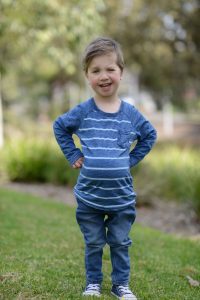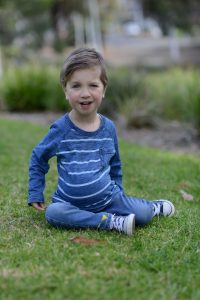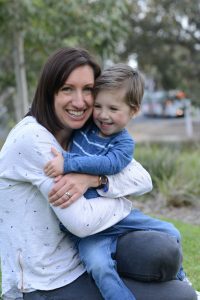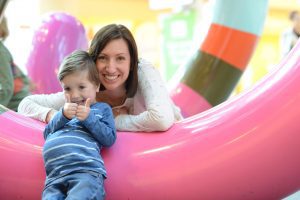From day one, little Sam has defied the odds.
In utero, doctors detected that Sam’s vital organs were outside his body. Sam was affected by a condition called omphalocele, a weakness in his abdomen where the umbilical cord joined it, meaning his liver, spleen and part of his bowels were protruding outside the abdominal cavity within a thin membrane sac. Suspecting that this was caused by a serious genetic disorder, doctors advised mum Amy and dad Mark to terminate the pregnancy.
“That was a scary time because we knew we were dealing with something really serious, but terminating the pregnancy was never an option for us,” said Amy.
An amniocentesis at 20 weeks was “the hardest part of the pregnancy”, as Amy and Mark waited for confirmation of their baby’s condition. Though a genetic disorder was ruled out, this good news was overshadowed by further updates from doctors.
“At every appointment the diagnosis got worse and worse. The first bit of hope we had was when we met with an RCH surgeon. That was the first bit of light we saw.”
Brought to the RCH shortly after birth, Sam spent the first four months of his life in the Newborn Intensive Care Unit (NICU). The pressure his omphalocele or ‘bump’, as the Gellie’s affectionately call it, put on his diaphragm hampered his breathing. Sam also had pulmonary hypoplasia, in which his lungs weren’t completely developed because his chest wall was narrow. Sam was put on a Continuous Positive Airway Pressure ventilator, which applies continuous mild air pressure to keep his airway open.
His bump was also at high risk of infection, and was monitored closely by doctors and dressed weekly until skin formed over it. Amy and Mark stayed by Sam’s cot day and night.
“We were in two headspaces while Sam was in NICU. So many people had said he was unlikely to make it, so we were thrilled that he had gotten that far. But then reality hit us and we saw him in the cot and realised that we couldn’t just hold him. When he was two weeks old, one of the nurses went above and beyond to make our first cuddle happen. The entire NICU team really helped us bond and connect with Sam, and made the best of a bad situation for us.”
At four months, Sam was discharged from NICU, but continued to visit the hospital on a weekly basis for the first year. Since then, “Sam’s had very few admissions and is doing really well.”
Eventually, Sam will undergo a series of operations with a team of surgeons including Mr Michael Nightingale.
“Sam is at the extreme end of the spectrum for omphalocele,” said Mr Nightingale. “All of his abdominal organs are within an hour-glass shaped sac and will need to be returned to his abdomen through the narrow end of it. This makes his case much more uncommon and complicated.”
Though Sam’s surgeons are waiting until he’s older before they begin operating, his treatment plan comprises three stages. The first will increase the size of his abdominal cavity so his organs can fit. The second will see surgeons return them to their rightful place. The third will reconstruct Sam’s abdominal wall.
“Sam has a significant medical condition and there will be challenges as we begin the surgeries, but he’s a brave, lovely little fellow.”
“He’s lucky to have such an amazing family, who have done a great job of caring for him.”
Until he’s old enough for surgery, Sam’s enjoying making everyone laugh and just being a kid.
“Sam doesn’t notice his bump at all or that he’s different. It doesn’t seem to stop him and he doesn’t let it get in his way.”



